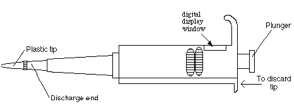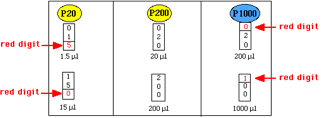Pipettors
The micropipette is used to transfer small amounts (<1 ml) of liquids. The scales on micropipettes are in microliters (1000µl = 1 ml). They come in several ranges of volumes as P20 = 0.5- 20 µl, P200 = 20-200 µl, and P1000 = 200-1000 µl. They are used in conjunction with disposable (often sterile) plastic tips; the smaller two micropipettors (P20 and P200) require the yellow tips and the P1000 pipettor uses the larger blue tips. The following is an illustration of a micropipettor:

Directions for use of the micropipette:
- Never exceed the upper or lower limits of these pipettors. The limits are:
P20: 0.5 to 20.0 µl P200: 20 to 200 µl P1000: 200 to 1000 µl
- Set the desired volume by turning the centrally located rings clockwise to increase volume or counterclockwise to decrease volume. Some examples are provided below:

-
Place a tip on the discharge end of the pipette.
-
The plunger will stop at two different positions when it is depressed.
The first of these stopping points is the point of initial resistance and is the level of depression that will result in the desired volume of solution being transferred. Because this first stopping point is dependent on the volume that is being transferred, the distance you have to push the plunger to reach the point of initial resistance will change depending on the volume being pipetted.
The second stopping point is used for the complete discharging of solutions from the plastic tip. You should not reach this second stop when drawing liquid into the pipette, only when expelling the last drop.
-
Depress the plunger until you feel the initial resistance and insert tip into the solution, just barely below the surface of the liquid and not as deep as possible.
-
Carefully and slowly release plunger. NOTE: If the solution you are pipetting is viscous, allow the pipet tip to fill to final volume before removing it from solution to avoid the presence of bubbles in the plastic tip which will result in an inaccurate volume.
-
Discharge the solution into the appropriate container by depressing plunger. This time, depress the plunger to the point of initial resistance, wait one second, and then continue pressing the plunger as far as it will go in order to discharge the entire volume of solution.
8.Remove tip by pressing down on the tip discarder.
- These instructions are adapted from Dr. Malcom Campbell Department of Biology, Davidson College. http://www.bio.davidson.edu/Courses/Bio111/Bio111LabMan/Preface%20D.html